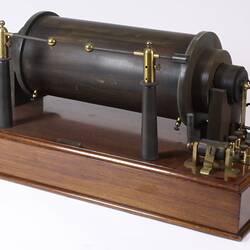Summary
Detector for use in a crystal radio receiver, with mechanical adjustment, circa 1916.
This unit is professionally made and 'is a German pattern detector said to have been used before World War I and afterwards to receive the Braybrook Broadcasting Station (inaugurated 13 October 1924 by Madame Melba).'
This detector is believed to have previously been owned (and probably used) by Francis West Chambers (1861-1928), who from 1909 held the position of electrical inspector for the Public Works Department of Victoria, with responsibility for supervising municipal power supply undertakings, and later held a similar role with the State Electricity Commission of Victoria from 1921 until his death. During the early 1900s he had collaborated with Henry Walter Jenvey in the first experimental wireless telegraphy transmissions in Australia.
Physical Description
The crystal is mounted in a brass cup on a wooden base plate. A brass spring loaded wire holder allows a delicate contact to be made between crystal and wire. With finger and thumb wheel adjustment screw. Metal components of contact arm and terminals are made of brass or other non-ferrous metals. This object is physically attached by a twisted wire to a cardboard display board on which a Coherer (ST 15415) is also mounted. Note: The crystal is probably actually galena (Lead Sulphide). Carborundum is unlikely to have been used at this time. It requires a battery to make it operational.
More Information
-
Collecting Areas
-
Acquisition Information
Donation from Mr E. W. Chambers, 09 Oct 1942
-
Date Made
-
Past Owner
Mr Francis W. Chambers, Mount Eagle, Heidelberg, Greater Melbourne, Victoria, Australia, circa 1920-1928
-
Inscriptions
None on detector. Display board labelling: 'EARLY SEMICONDUCTOR DEVICES / THE COHERER - 1905 [refers to ST 15415] / THE CRYSTAL DETECTOR - 1920 [refers to ST 21766] / A crystal of CARBURUNDUM (Silicon Carbide) in point / contact with a wire called a CAT'S WHISKER rectified / incoming RADIO FREQUENCY SIGNALS.' Note: Carborundum is misspelt on display board.
-
Classification
-
Category
-
Discipline
-
Type of item
-
Overall Dimensions
114 mm (Length), 63 mm (Width), 68 mm (Height)
Dimensions of wooden base only: 114 mm x 63 mm x 10 mm. Adjustment thumb wheel 22 mm diameter x 6 mm. Crystal is mounted in a 15 mm diameter x 10 mm high cup.
-
Other Dimensions
284 mm (Length), 202 mm (Width)
Dimensions of display board.
-
Keywords
Electrical Components, Radio Broadcasting, Radios, Wireless Technology, World War I, 1914-1918


